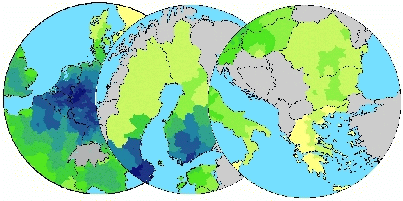Peripherality (2000) |
| Towards a European Peripherality Index E.P.I. |
|
|
|
The purpose of this study for the General Directorate XVI Regional Policy of the European Commission was to calculate indicators of peripherality of the 'potential' type for the fifteen Member States of the European Union and the twelve candidate countries in Eastern Europe. The economic or population potential of a region is the total of destinations (firms or population) in all regions weighted by a function of distance from the origin region. The peripherality indicators calculated will be based on Level 3 of the Nomenclature of Territorial Units for Statistics (NUTS) of the Statistical Office of the European Union and equivalent geographical units as for the candidate countries and aggregated to NUTS levels 2, 1 and 0 as weighted average of the corresponding NUTS-3 regions. Distance measures used are average road travel times of passengers and goods taking account of road types, speed limits for cars and lorries, congestion in urban regions and of delays due to mountainous areas, national borders and maximum driving hours of lorry drivers. Selected results have been incorporated in the Second Cohension Report of the European Commission. The final report of the study can be downloaded from Inforegio homepage of the European Commission as well. The calculated indicators are part of the overall RRG GIS Database, section interaction data and regional data, and can be ordered upon request.
|
|
|


